Do Manual Transmission Cars Have Cruise Control?
By: Author Zach Reed
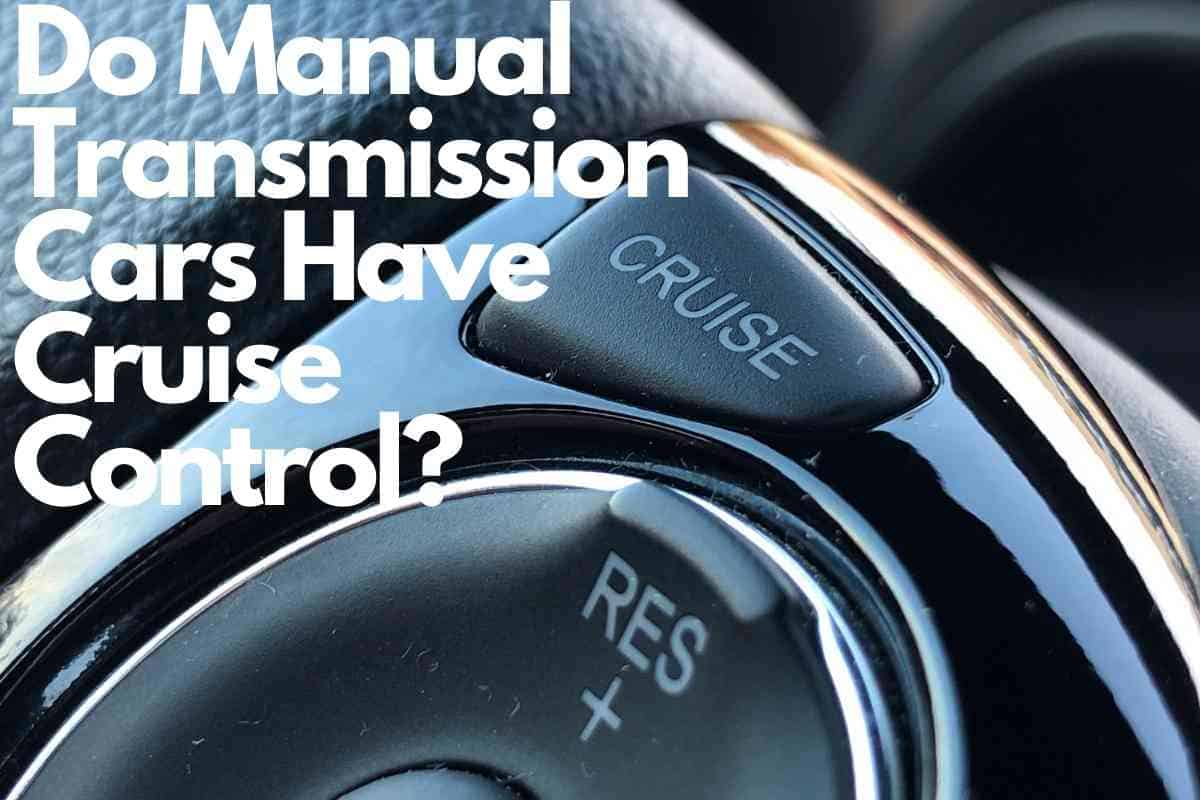
Cruise control is an awesome feature for anyone hitting the highways .
Many people with manual transmission vehicles don’t know if their cars have this magnificent feature.
If you drive on the highway a lot and are considering a manual vehicle, you definitely need to know whether manual transmission cars have cruise control or not.
Manual transmission vehicles often do come with cruise control, although it works a little different from the cruise control in automatic vehicles. Adaptive Cruise Control (ACC) comes standard on most new Manual vehicles and can safely be engaged so long as you plan on remaining in the same gear.
When safely engaged, cruise control is an excellent feature that can ease some of the strain of long car rides.
Knowing what cruise control is and how to engage it, especially in manual transmission vehicles, is crucial to safely operate your vehicle.
Continue reading for all you need to know about manual vehicles and cruise control.

What is Cruise Control In A Stick-Shift Car?
The cruise control is an electronic system that allows a driver to maintain the vehicle’s accelerator at a certain speed even when they take their foot off the gas pedal.
It’s comparable to driving on autopilot. It works best on straight roads with less traffic.
Vehicles with manual transmission require the drive to manually depress the clutch pedal and shift into the gear they need.
If the vehicle has cruise control, this will automatically cause the cruise control to disengage .
Therefore, manual cars will benefit from cruise control on highway/motorway speeds where one gear is used the whole time .
Adaptive cruise control (ACC) has slowly but surely started replacing the standard cruise control . This is because of the number of vehicles on the roads today.
It works in the same way as the normal cruise control but with smart speed management. It speeds up and slows down depending on the speed of the vehicle ahead.
This helps prevent accidents even if the driver didn’t respond fast enough.
Almost all vehicles nowadays are manufactured with adaptive cruise control as a standard feature.
The feature maintains a safe distance from the vehicle ahead and will slow down or stop if the other vehicle does the same.
It will also resume the previous speed if the car in front does the same.
Read on to understand the importance of cruise control especially in manual cars and how it affects your car’s engine.
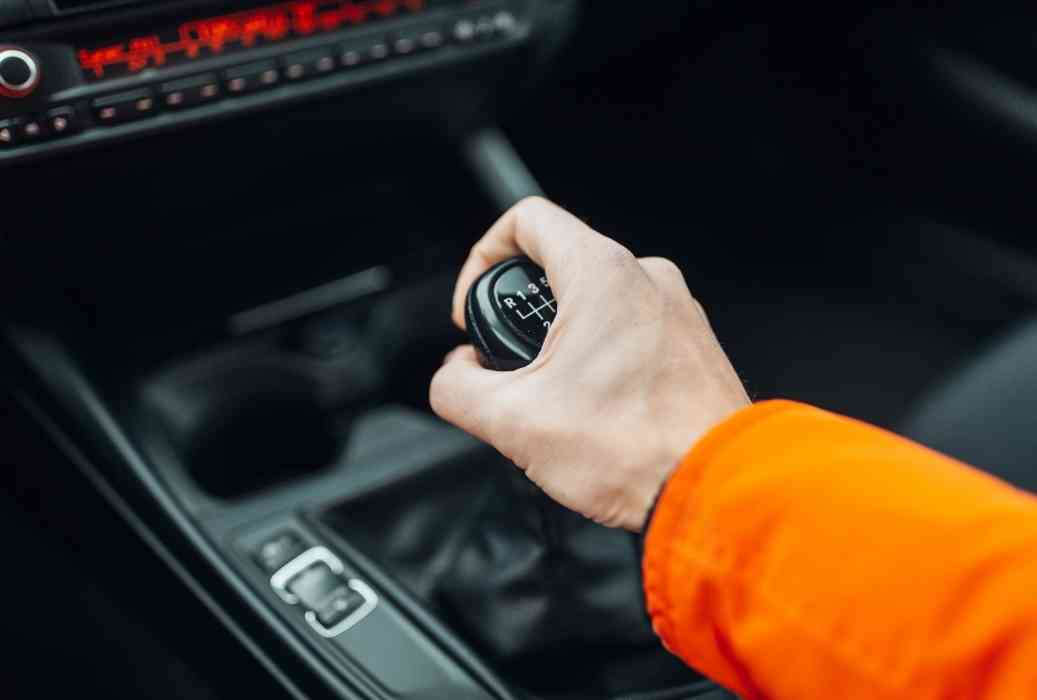
Adaptive Cruise Control on Manual Cars
It’s important to know that the adaptive cruise control disengages every time you hit the clutch.
Therefore, you will turn on cruise control after you have already shifted your gears.
This doesn’t affect you much anyway because it means you are either looking to slow down or speed up.
It also disengages when the RPM is either too high or too low.
If it detects slow traffic ahead of you, it will slow down as long as the speed difference doesn’t lower your RPM too much.
If you need to downshift because your RPM dropped too low, the system will automatically turn off.
Manual cars have a problem with cruise control when going up steep terrains.
You will have to turn off cruise control in such a situation and only restart if after you have adjusted your gears.
Considerations for Using Cruise Control
- It comes in handy during long drives on highways and roads with little to no traffic. It can be helpful to a fatigued driver as well as safely allow the vehicle’s positioning changes.
- It’s useful for drivers who unknowingly increase speeds while driving. It helps them avoid violating speed limits by maintaining a steady speed.
- It’s fuel-efficient as it helps the vehicle maintain a steady speed.
Disadvantages
However, it’s not always going to work out while using cruise control with accidents as an extreme consequence.
There are a number of cons that can occur when cruise control isn’t used correctly. They include:
- Cruise control doesn’t work properly during harsh weather conditions.
- There may be an acceleration round bends that require the vehicle to slow down.
- Rough terrain can mess with the cruise control controls.
- It makes drivers dependable on the feature thus paying less attention to the road when driving. This could lead to serious accidents.
- Inattentive drivers are at risk of Sudden Unintended Acceleration (SUA). This happens when a driver accidentally hits the accelerator when they meant to hit the brakes in an emergency, causing an accident.
Will Cruise Control Mess up Your Engine?
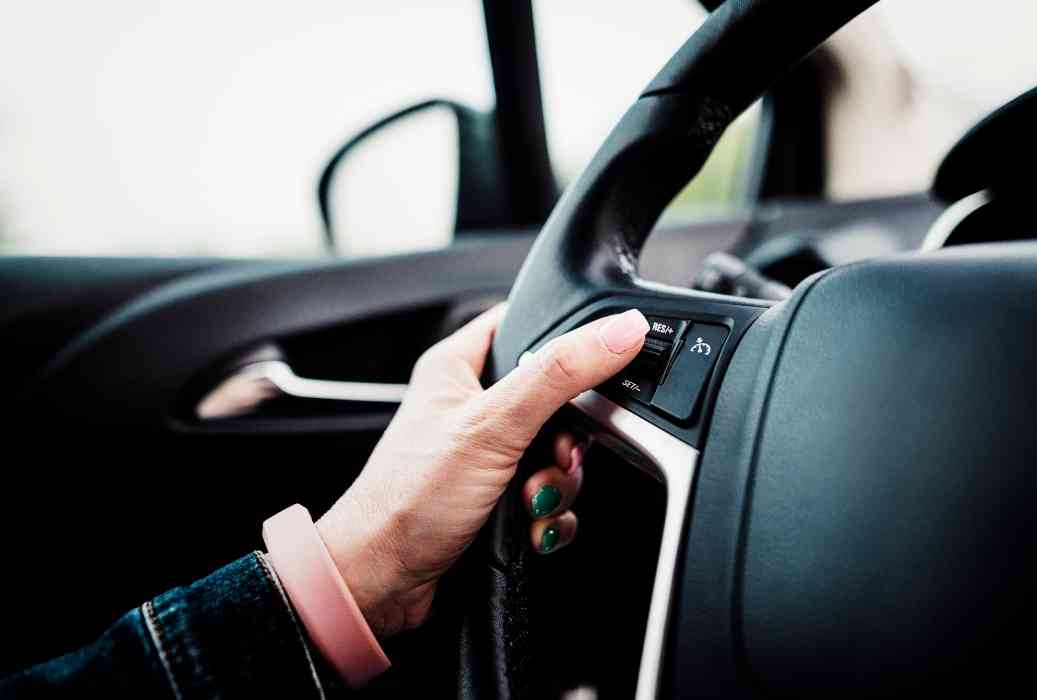
Cruise control won’t affect your engine negatively if your vehicle is automatic . When used correctly, it saves you money in the long run.
Because of its smooth acceleration, your vehicle becomes more fuel-efficient.
In manual cars, however, there might be some lag when going up steep terrains. In the long run, it is possible to cause damage but, in most cases, it’s okay to use.
Cruise Control In Manuals
As discussed above, many car manufacturers are moving from normal cruise control to adaptive cruise control.
Manual cars do have cruise control although it works a little different from the cruise control in automatic vehicles.
Cruise control is useful for long drives and ends up saving you money on fuel and speeding tickets.
Related Posts
- Is It Bad To Start A Car In 2nd Gear?
Hi, I'm the founder of VehicleAnswers.com! Having owned a wide variety of vehicles in my life, I was astounded at how hard it can be to find answers to common automotive questions. Rather than sit idly, I decided to create this website to help others!
- Hybrids & EVs
- Tips, Tricks & Trends
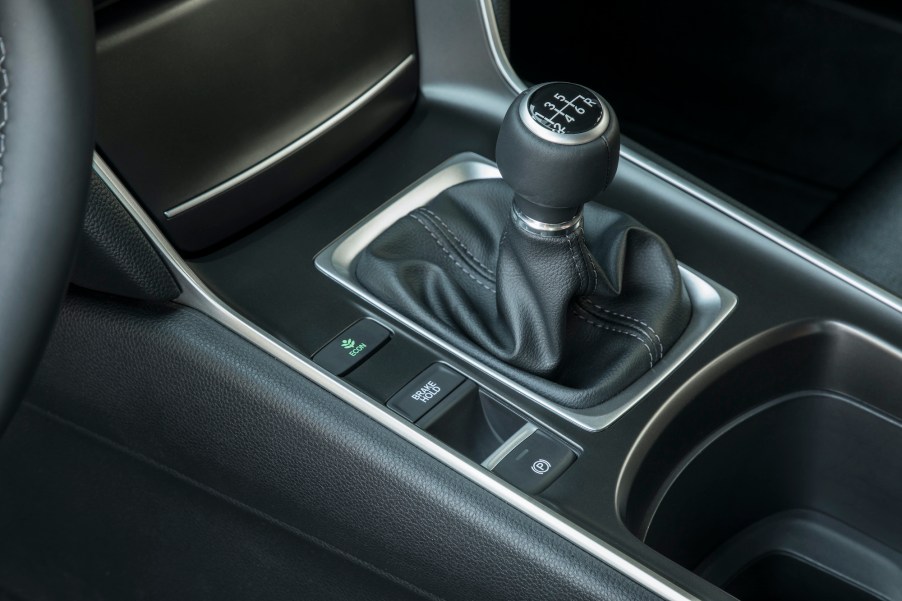
Does Adaptive Cruise Control Work With a Manual Transmission?
Adaptive cruise control has been around for quite a while now and it is even a standard feature in some of the most affordable cars on the market. Adaptive cruise control adds a bit of extra safety and convenience to your day, especially if your car is equipped with an automatic transmission. But what you might not know is that it’s also available on cars with a manual transmission as well. But how does it work?
Adaptive cruise control is not like regular cruise control
At first, it might seem like a manual transmission and adaptive cruise control wouldn’t work well together. We say this because, unlike regular cruise control, adaptive cruise control regulates the car’s speed. And when the car slows down, the RPMs will drop, which would cause a manual transmission car to either bog or stall. But in a car with an automatic transmission, the car will easily slow down and even come to a complete stop with the adaptive cruise control engaged.
So how does it work with a manual transmission ? According to Autotrader, adaptive cruise control in a car with a manual transmission works half as good as one with an automatic because the system will regulate the car’s speed when cruising, but when it’s time to slow the car down or stop, the system will disengage.

“Low-speed follow” is not allowed
Another advantage of having an adaptive cruise control system on a car with an automatic transmission is that the car will actually take care of itself in stop-and-go traffic. When traffic slows down, the system will detect the car in front of you and adjust to its speed, effectively doing the “traffic dance” for you. However, for cars with a manual transmission, this feature is not included since you would have to depress the clutch and shift gears manually in order to keep the car going.
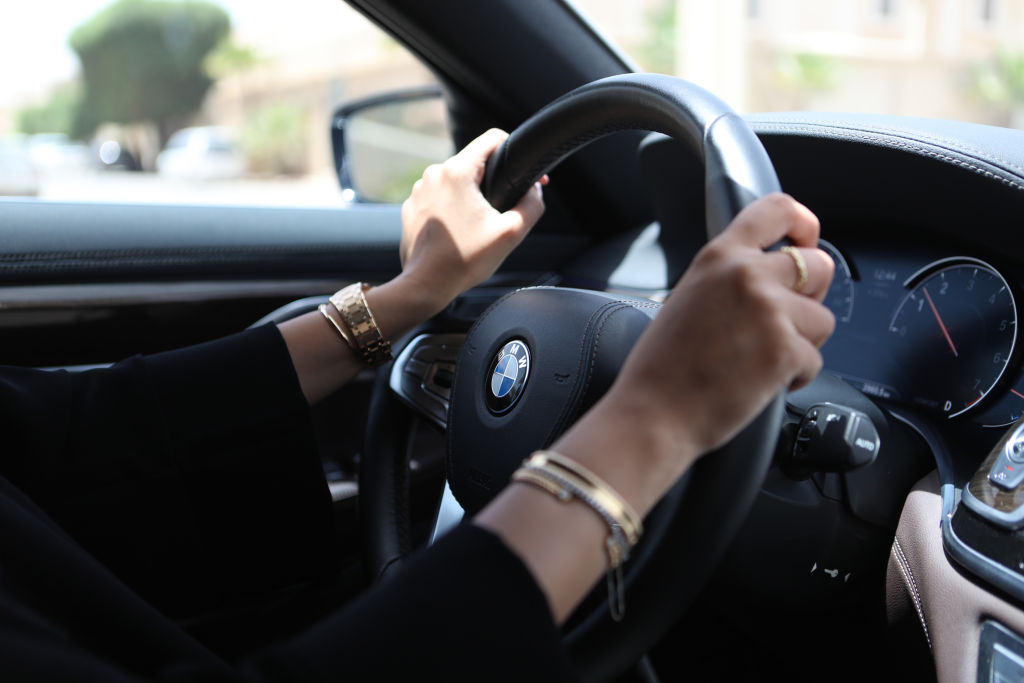
It’s still an effective safety feature to have
You might be wondering why any automaker would include adaptive cruise control on a car with a manual transmission if you’re only able to use half of what the feature has to offer. Considering adaptive cruise control is a safety feature it’s still great to have on any car as it will make the car hit the brakes and slow down if a car were to suddenly cut in front of you or slow down abruptly on the freeway.
Sure, you might not be able to take the stress out of sitting in rush-hour traffic on a Friday, or any day for that matter, but you can at least still set it and forget under normal driving conditions.
However, we must warn you that if you do ever use the adaptive cruise control feature on a car with a manual transmission, remember to stay extra alert when it slows the car down or accelerates it while on the freeway, you might just forget to shift gears. Otherwise, we highly recommend using this feature as it’s extremely useful in almost any driving situation and there’s an added bit of safety as well.
How to Avoid Hitting a Deer With Your Car This Fall

Watch this Dodge RAM driver take out a gas pump, start a fire, and run like hell

Staying silent during a traffic stop can come back to bite you

Does the president really fly in Marine One with decoys?

Joe Santos has been an automotive journalist since 2013 and joined MotorBiscuit in 2020. He writes strongly on consumer advice and new cars, and we consider him an asset to readers looking for guidance in buying and selling autos.
Joe earned a Bachelor’s in Journalism from California State University, Fullerton, and spent years as a Road Test Editor at Kelley Blue Book, after which he served in various automotive-related roles, including an autonomous vehicle trainer for GM, a vehicle sales manager, and an Audi brand specialist.
Joe’s prized possession is a 2008 Honda S2000 in Laguna Blue Pearl, with which he attends local car meets. Joe is also a content creator for LTD Global, a B2B support firm.
Advertisement
How Cruise Control Systems Work
- Share Content on Facebook
- Share Content on LinkedIn
- Share Content on Flipboard
- Share Content on Reddit
- Share Content via Email
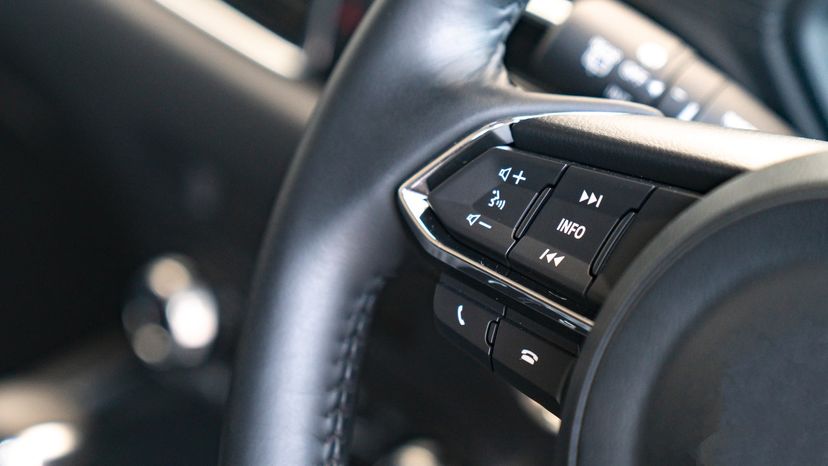
Cruise control is an invaluable feature on American cars. Without cruise control, long road trips would be more tiring, for the driver at least, and those of us suffering from lead-foot syndrome would probably get a lot more speeding tickets.
Cruise control is far more common on American cars than European cars, because the roads in America are generally bigger and straighter, and destinations are farther apart. With traffic continually increasing, basic cruise control is becoming less useful, but instead of becoming obsolete, cruise control systems are adapting to this new reality -- soon, cars will be equipped with adaptive cruise control, which will allow your car to follow the car in front of it while continually adjusting speed to maintain a safe distance.
In this article, we'll learn how a conventional cruise control system works, and then we'll take a look at adaptive cruise control systems that are under development.
What Cruise Control Does
Cruise control acceleration and deceleration, controlling the cruise control, adaptive cruise control.
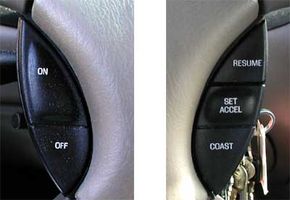
The cruise control system actually has a lot of functions other than controlling the speed of your car. For instance, the cruise control pictured below can accelerate or decelerate the car by 1 mph with the tap of a button. Hit the button five times to go 5 mph faster. There are also several important safety features -- the cruise control will disengage as soon as you hit the brake pedal, and it won't engage at speeds less than 25 mph (40 kph).
The system pictured below has five buttons: On, Off, Set/Accel, Resume and Coast. It also has a sixth control -- the brake pedal, and if your car has a manual transmission the clutch pedal is also hooked up to the cruise control.
- The on and off buttons don't actually do much. Hitting the on button does not do anything except tell the car that you might be hitting another button soon. The off button turns the cruise control off even if it is engaged. Some cruise controls don't have these buttons; instead, they turn off when the driver hits the brakes, and turn on when the driver hits the set button.
- The set/accel button tells the car to maintain the speed you are currently driving. If you hit the set button at 45 mph, the car will maintain your speed at 45 mph. Holding down the set/accel button will make the car accelerate; and on this car, tapping it once will make the car go 1 mph faster.
- If you recently disengaged the cruise control by hitting the brake pedal, hitting the resume button will command the car to accelerate back to the most recent speed setting.
- Holding down the coast button will cause the car to decelerate, just as if you took your foot completely off the gas. On this car, tapping the coast button once will cause the car to slow down by 1 mph.
- The brake pedal and clutch pedal each have a switch that disengages the cruise control as soon as the pedal is pressed, so you can shut off the cruise control with a light tap on the brake or clutch.
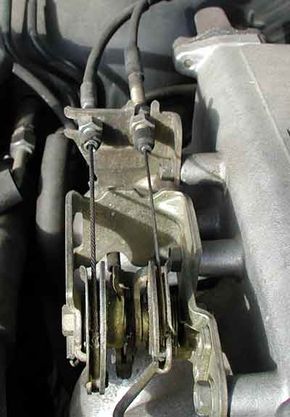
The cruise control system controls the speed of your car the same way you do -- by adjusting the throttle position . But cruise control actuates the throttle valve by a cable connected to an actuator , instead of by pressing a pedal. The throttle valve controls the power and speed of the engine by limiting how much air the engine takes in (see How Fuel Injection Systems Work for more details).
In the picture above, you can see two cables connected to a pivot that moves the throttle valve. One cable comes from the accelerator pedal, and one from the actuator. When the cruise control is engaged, the actuator moves the cable connected to the pivot, which adjusts the throttle; but it also pulls on the cable that is connected to the gas pedal -- this is why your pedal moves up and down when the cruise control is engaged.
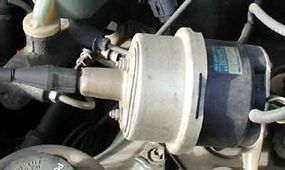
Many cars use actuators powered by engine vacuum to open and close the throttle. These systems use a small, electronically-controlled valve to regulate the vacuum in a diaphragm. This works in a similar way to the brake booster , which provides power to your brake system.
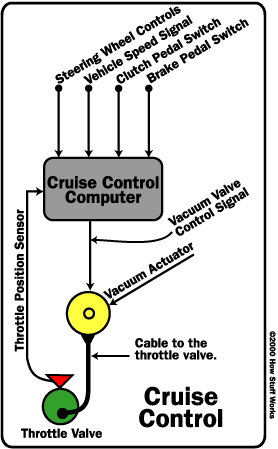
The brain of a cruise control system is a small computer that is normally found under the hood or behind the dashboard. It connects to the throttle control seen in the previous section, as well as several sensors. The diagram below shows the inputs and outputs of a typical cruise control system.
A good cruise control system accelerates aggressively to the desired speed without overshooting, and then maintains that speed with little deviation no matter how much weight is in the car, or how steep the hill you drive up. Controlling the speed of a car is a classic application of control system theory . The cruise control system controls the speed of the car by adjusting the throttle position, so it needs sensors to tell it the speed and throttle position. It also needs to monitor the controls so it can tell what the desired speed is and when to disengage.
The most important input is the speed signal; the cruise control system does a lot with this signal. First, let's start with one of the most basic control systems you could have -- a proportional control .
In a proportional control system, the cruise control adjusts the throttle proportional to the error, the error being the difference between the desired speed and the actual speed. So, if the cruise control is set at 60 mph and the car is going 50 mph, the throttle position will be open quite far. When the car is going 55 mph, the throttle position opening will be only half of what it was before. The result is that the closer the car gets to the desired speed, the slower it accelerates. Also, if you were on a steep enough hill, the car might not accelerate at all.
Most cruise control systems use a control scheme called proportional-integral-derivative control (a.k.a. PID control). Don't worry, you don't need to know any calculus to make it through this explanation -- just remember that:
- The integral of speed is distance.
- The derivative of speed is acceleration.
A PID control system uses these three factors -- proportional, integral and derivative, calculating each individually and adding them to get the throttle position.
We've already discussed the proportional factor. The integral factor is based on the time integral of the vehicle speed error . Translation: the difference between the distance your car actually traveled and the distance it would have traveled if it were going at the desired speed, calculated over a set period of time. This factor helps the car deal with hills, and also helps it settle into the correct speed and stay there. Let's say your car starts to go up a hill and slows down. The proportional control increases the throttle a little, but you may still slow down. After a little while, the integral control will start to increase the throttle, opening it more and more, because the longer the car maintains a speed slower than the desired speed, the larger the distance error gets.
Now let's add in the final factor, the derivative . Remember that the derivative of speed is acceleration. This factor helps the cruise control respond quickly to changes, such as hills. If the car starts to slow down, the cruise control can see this acceleration (slowing down and speeding up are both acceleration) before the speed can actually change much, and respond by increasing the throttle position.
Two companies are developing a more advanced cruise control that can automatically adjust a car's speed to maintain a safe following distance. This new technology, called adaptive cruise control , uses forward-looking radar , installed behind the grill of a vehicle, to detect the speed and distance of the vehicle ahead of it.
Adaptive cruise control is similar to conventional cruise control in that it maintains the vehicle's pre-set speed. However, unlike conventional cruise control, this new system can automatically adjust speed in order to maintain a proper distance between vehicles in the same lane. This is achieved through a radar headway sensor , digital signal processor and longitudinal controller . If the lead vehicle slows down, or if another object is detected, the system sends a signal to the engine or braking system to decelerate. Then, when the road is clear, the system will re-accelerate the vehicle back to the set speed.
The 77-GHz Autocruise radar system made by TRW has a forward-looking range of up to 492 feet (150 meters), and operates at vehicle speeds ranging from 18.6 miles per hour (30 kph) to 111 mph (180 kph). Delphi's 76-GHz system can also detect objects as far away as 492 feet, and operates at speeds as low as 20 mph (32 kph).
Adaptive cruise control is just a preview of the technology being developed by both companies. These systems are being enhanced to include collision warning capabilities that will warn drivers through visual and/or audio signals that a collision is imminent and that braking or evasive steering is needed.
For more information on cruise control, check out the links below.
Cruise Control FAQ
How does cruise control work, how does adaptive cruise control work, will adaptive cruise control stop the vehicle, when would you use cruise control, how useful is cruise control, lots more information, related articles.
- How Car Engines Work
- How Brakes Work
- How Manual Transmissions Work
- How Fuel Injection Systems Work
- How Radar Detectors Work
- Ignition System Quiz
More Great Links
- BMW: Cruise-control-equipped motorcycle
- Cruise Control Block Diagram
- Cruise Control Installers' Instructions
- Cruise Control Service Tips
Please copy/paste the following text to properly cite this HowStuffWorks.com article:

IMAGES